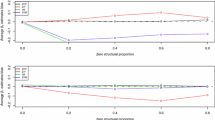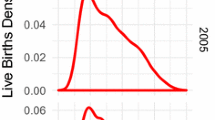Abstract.
This paper models household fertility decisions by using a generalized Poisson regression model. Since the fertility data used in the paper exhibit under-dispersion, the generalized Poisson regression model has statistical advantages over both standard Poisson and negative binomial regression models, and is suitable for analysis of count data that exhibit either over-dispersion or under-dispersion. The model is estimated by the method of maximum likelihood. Approximate tests for the dispersion and goodness-of-fit measures for comparing alternative models are discussed. Based on observations from the Panel Study of Income Dynamics of 1989 interviewing year, the empirical results support the fertility hypothesis of Becker and Lewis (1973).
Similar content being viewed by others
Author information
Authors and Affiliations
Additional information
Received January 7, 1997 /Accepted April 3, 1997
Rights and permissions
About this article
Cite this article
Wang, W., Famoye, F. Modeling household fertility decisions with generalized Poisson regression. J Popul Econ 10, 273–283 (1997). https://doi.org/10.1007/s001480050043
Issue Date:
DOI: https://doi.org/10.1007/s001480050043




